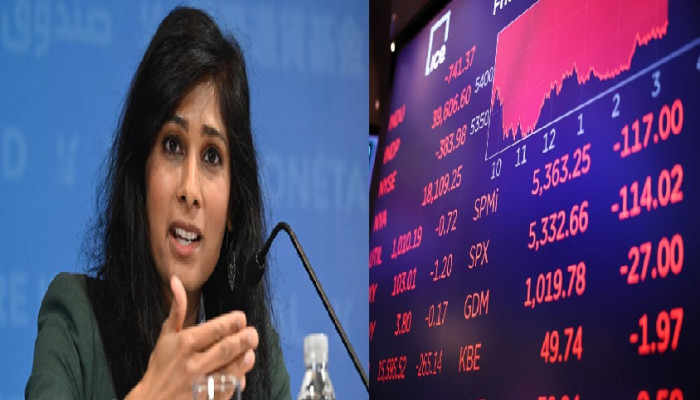The Sky Isn’t Falling: A Rebuttal to Alarmist Market Crash Predictions by a Harvard Economist
- In Economics
- 11:30 AM, Oct 22, 2025
- Viren S Doshi
The recent article by Gita Gopinath, published on October 15, 2025, in The Economist, paints a dire picture of a potential $35 trillion wealth wipeout tied to an overreliance on American stocks, drawing parallels to the dotcom crash of 2000. As the Gregory and Ania Coffey Professor of Economics at Harvard University and former First Deputy Managing Director of the International Monetary Fund (IMF), the writer’s credentials lend certain weight to her warnings. However, the Harvardian Academician’s analysis leans heavily on speculative fears, selective data, and a narrative that unfairly targets American economic dominance while understating strong global resilience, particularly led by India and the Global South, while remaining completely silent on monopolies of opaque CCP-occupied China threatening the free world for three decades. (For clarity, we will refer to China as the Chinese Communist Party (CCP)-occupied China to reflect its political reality.)
This counteroffensive dismantles her arguments, addresses her anti-conservative undertones, and offers a more balanced perspective on the risks and opportunities in today’s global markets. The ex-IMF bureaucrat overlooks the transformative impact of Republican President Donald Trump’s conservative economic measures, which are fortifying U.S. fiscal health and driving sustainable growth.
The Dotcom Comparison: A Flawed Analogy
The Harvardian Economist likens the current surge in American stocks, driven by enthusiasm for artificial intelligence (AI), to the dotcom bubble of the late 1990s. She suggests that this “exuberance” could precipitate a market correction with catastrophic global consequences. This comparison oversimplifies the dynamics of today’s market. The dotcom crash stemmed from speculative investments in unprofitable tech startups that lacked solid fundamentals, as the ex-IMF bureaucrat herself notes. In contrast, today’s rally, even if it is partly AI-driven, is anchored by established giants (like NVIDIA, Microsoft, and Amazon and many others), which boast robust revenue streams, proven business models, and tangible contributions to productivity. For instance, AI advancements have driven measurable efficiency gains across industries, from logistics to healthcare, unlike the speculative frenzy of the dotcom era, where companies like Pets.com collapsed under their own hype. The market did correct at that time, but Information Technology gave a new dimension to life on Earth and even in Space. The Harvardian Academician ignores the resilience of markets after the dot-com crash. While the NASDAQ fell 78% from its peak in 2000, survivors like Amazon not only recovered but redefined global commerce.
The current market is more diversified, with AI impacting sectors far beyond tech, such as manufacturing and energy. Claiming AI enthusiasm is the “sole or major reason” for the rally in the market is reductive. Other factors, including post-pandemic recovery, strong corporate earnings, low unemployment (3.8% in the U.S. as of September 2025), and Trump’s pro-growth policies, bolster market confidence. The ex-IMF bureaucrat’s failure to acknowledge these broader drivers fuels this skewed narrative of impending doom, which otherwise could have been a rather well-reasoned caution.
Overblown Wealth Loss Projections
The Economist’s headline figure—a potential $35 trillion wealth loss ($20 trillion for American households and $15 trillion for foreign investors)—is eye-catching but lacks transparent methodology. Her write-up is silent on the basis of this big number.
The ex-IMF bureaucrat claims a correction on the scale of the dotcom crash could erase 70% of U.S. Gross Domestic Product (GDP), approximately $28.6 trillion in 2024. Her estimate assumes a uniform market drop applied to current valuations, but she provides no detailed calculations or scenarios (e.g., a specific percentage decline in the S&P 500). The dotcom crash saw the NASDAQ lose roughly 50% of its value over two years, but the broader S&P 500 fell only 36%. Applying a similar drop to today’s $50 trillion U.S. market capitalisation yields losses far below $20 trillion for households, especially since only 65% of U.S. equities are domestically held.
For foreign investors, the Harvardian Academician estimates $15 trillion in losses, although their holding of around 20% of U.S. market capitalisation may warrant reevaluation of this large figure. This estimate is plausible only in an extreme scenario where global markets collapse simultaneously, neglecting diversification across asset classes and regions. For example, Indian investors have minimal exposure to U.S. equities compared to Europe or Japan, which limits their risk. The ex-IMF bureaucrat’s global spillover narrative overstates interconnectedness while underestimating emerging markets' ability to decouple from U.S. shocks, as demonstrated during the 2008 financial crisis when India and China, maintained growth.
Consumption and GDP Impacts: Exaggerated Fears
Gopinath warns that a market crash could slash U.S. consumption growth by 3.5 percentage points, leading to a two-percentage-point hit to GDP growth. This assumes a direct translation of wealth losses to spending cuts, ignoring consumer behaviour nuances. During the dotcom crash, U.S. consumption growth dipped but rebounded swiftly due to monetary policy easing and fiscal stimulus. Today, with household debt-to-income ratios at historic lows (85% in 2025 versus 100% in 2000) and savings rates stable at 4.8%, American consumers are better positioned to weather any market correction. Her claim that consumption is “weaker than it was preceding the dotcom crash” is worth scrutinising; real personal consumption expenditure grew 2.5% annualised in Q2 2025, outpacing the 2.2% average in 1999.
Globally, her $15 trillion foreign wealth loss estimate (20% of non-U.S. GDP) overstates the impact by assuming uniform exposure and no mitigating factors. For example, Europe’s diversified portfolios and Asia’s growing domestic markets provide buffers. The world's fastest growing India’s low-exposure economy underscores that not all economies are equally vulnerable. Her reluctance to quantify these differences fuels the alarmist tone.
The Dollar’s Role: Misreading “Flight to Safety”
Gopinath argues that the U.S. dollar may not appreciate during a future crisis, undermining its “flight to safety” status. She cites recent dollar weakness despite expectations of stronger tariffs and fiscal policy, but offers no concrete reasons for this shift. This claim ignores the dollar’s structural dominance: it accounts for 58% of global foreign exchange reserves and nearly 88% of foreign exchange transactions (where the dollar is involved in one leg of the trade, per the Bank for International Settlements’ 2022 Triennial Central Bank Survey, with stability into 2025), which encompass a broad spectrum of international transactions including but not limited to SWIFT-based payments. SWIFT, the dominant network for interbank messaging in cross-border payments, shows the dollar’s share at around 50% of such payments as of mid-2025—far higher than alternatives like the euro (about 23%)—but this understates the dollar’s overall role in non-SWIFT channels like direct bilateral settlements, trade invoicing (54% of global exports), and regional systems (e.g., CIPS in CCP-occupied China or CHIPS in the U.S.), where dollar usage remains prevalent. Even in crises originating in the U.S., such as 2008, the dollar strengthened as investors sought liquidity and stability. And even if foreign investors are hedging against the dollar, hedging costs remain high, and alternatives like the euro and yuan are less liquid and less trusted. Hasty hedging is aptly likened to an axe falling on one’s own self — such moves could lock in losses rather than mitigate them.
Institutional Trust and the Federal Reserve
Gopinath’s allegation that “legal and political challenges” threaten the Federal Reserve’s independence is a veiled critique of conservative policies, reflecting her Harvard-honed bias toward interventionist frameworks. Recent debates over Fed policy, such as proposed oversight reforms, have not materially altered its operations. Notably, Trump and his team have repeatedly criticised the Fed’s extravagant spending, such as the $250 million renovation of its Washington, D.C. headquarters, which they argue diverts resources from core monetary policy functions and fuels perceptions of bureaucratic excess, while the Fed has persistently resisted revision of interest rates. The Fed’s dual mandate—price stability and full employment—remains intact, and markets continue to trust it to manage crises, as evidenced by stable Treasury yields (4.1% for 10-year notes in October 2025). Her warning about eroding trust in American institutions feels more like a political jab than an economic argument, especially given the U.S.’s consistent ranking among the top globally for institutional stability.
Tariffs and Global Trade: A Balanced View
Gopinath’s focus on “tit-for-tat tariffs” between the U.S. and China exaggerates their impact. Tariffs, while disruptive, have not crippled global trade. U.S. tariffs on CCP-occupied China have spurred supply chain diversification, benefiting other countries like Vietnam and Mexico. CCP-occupied China’s critical-mineral export controls are a concern, which no economist of the clan of Harvard criticises or fears, but global markets have adapted, with Australia and Canada ramping up production.
Far from being a drag, Trump’s tariffs are adding substantial revenue to federal coffers—exceeding $30 billion per month by September 2025, up from under $10 billion in 2024—providing fiscal flexibility for growth initiatives. Projections indicate these tariffs could generate up to $3.8 trillion over the next decade, offsetting tax cuts and funding infrastructure without exacerbating deficits.
Gopinath’s claim that fiscal stimulus is limited due to high debt levels is questionable. Recent measures to improve the U.S. fiscal position, such as spending recissions, targeted tax reforms and infrastructure spending, bolster resilience. The U.S. debt-to-GDP ratio (126% in 2025) is high but manageable, given low real interest rates and strong growth (2.7% annualised in Q2 2025). Trump’s tariffs, along with a 1% remittance tax on outbound transfers by immigrants and such other measures to raise collections, are projected to yield billions more in revenue, while bolstering domestic investment.
Growth Imbalances: A Call for Perspective
Gopinath argues that global growth is overly concentrated in the U.S., making markets “narrow and fragile.” This overlooks the dynamism of emerging markets. India’s GDP growth of 6.8% in 2025 and ASEAN’s 5.2% average demonstrate that global growth is diversifying. Her call for Europe to deepen integration ignores its structural challenges, like labour market rigidity and energy dependence.
Meanwhile, the Harvardian Economist’s nod to “this year’s Nobel laureates” for innovation-led growth feels like academic posturing. Capital flows to emerging markets, which she acknowledges, are not stalling but accelerating, with $1.2 trillion in foreign direct investment in 2024 (UNCTAD data).
Trump’s conservative measures are supercharging this balance. Through the Department of Government Efficiency (DOGE), the administration has implemented aggressive spending cuts, including a deferred resignation program for federal employees that saves billions by streamlining bureaucracy, along with curbs on leftist ideology caused wasteful expenses. Curbs on illegal immigration—via executive orders ending catch-and-release policies and allocating $75 billion for detention and enforcement—could slash taxpayer costs by up to $182 billion annually, according to the Federation for American Immigration Reform, freeing resources for American families and businesses. The lifetime fiscal drain per illegal immigrant, estimated at $68,000, underscores the savings potential.
On investment, Trump’s “One Big Beautiful Bill” renews 100% immediate expensing for equipment and research and development, expands the small business deduction to 23% (creating over 1 million jobs and $750 billion in growth), and allows full expensing for new factories—directly countering the Harvardian Academician’s fragility concerns by incentivising domestic production. Deregulation via Executive Order 14255 (the “10-to-1” rule, requiring 10 rules repealed for every new one) and the Investment Accelerator is unleashing prosperity, with manufacturing investments holding steady at 2024 levels amid reshoring.
These policies, paired with tax cuts projected to boost GDP by 1.2% long-term, are fostering balanced, resilient growth.
Conclusion: Preparing Without Panic
The ex-IMF bureaucrat leverages her IMF pedigree to sound a clarion call for a market crash, but her arguments rely on worst-case scenarios and selective framing. The global economy is more resilient than she suggests, with diversified markets, adaptive supply chains, and robust policy tools—amplified by the Trump Administration’s focus on fiscal discipline and investment incentives.
Her anti-conservative slant—evident in critiques of tariffs, Fed independence, and silence on its lavish $250 million headquarters renovation—betrays a preference for centralised, interventionist policies over market-driven solutions.
While a section of economists is almost never worried about three decades of monopolies of opaque CCP-occupied China's systems, and always panicking about a “projected” $35 trillion apocalypse, investors and policymakers should focus on prudent diversification, fiscal discipline, and fostering innovation across regions.
The sky isn’t falling; it’s cloudy at the most, and the U.S. still remains a seat of economic stability despite its unprecedented challenge of the CCP-occupied China-led monopolistic order, leading to a lot of turbulence in the world.
Disclaimer: The opinions expressed within this article are the personal opinions of the author. MyIndMakers is not responsible for the accuracy, completeness, suitability, or validity of any information on this article. All information is provided on an as-is basis. The information, facts or opinions appearing in the article do not reflect the views of MyindMakers and it does not assume any responsibility or liability for the same.







Comments